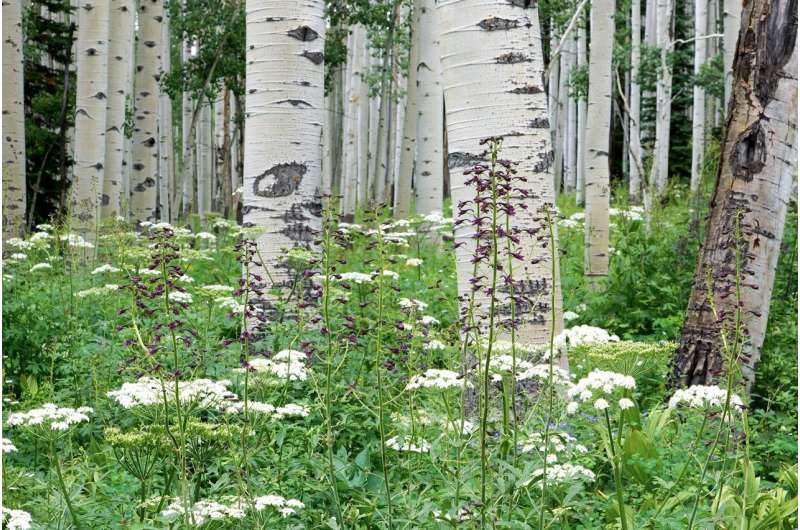This article has been reviewed according to Science X's editorial process and policies. Editors have highlighted the following attributes while ensuring the content's credibility:
fact-checked
peer-reviewed publication
trusted source
proofread
Research suggests climate change will disrupt many age-old partnerships between aspen trees and fungi

Standing in an aspen grove, surrounded by slender white trunks and a canopy of leaves that rustle in the slightest breeze, it's easy to think only of the trees.
Hidden in the roots, soil, and fluttering leaves, however, are complex networks of fungi. Some fungi in these networks can help aspens and closely related trees in the genus Populus absorb water and nutrients from soil, while others may cause disease in the plants' leaves.
Recent research from Stanford University suggests climate change will disrupt the balance between helpful and harmful fungi in Populus groves, as rising temperatures and shifting precipitation patterns lead to fewer kinds of beneficial soil and root fungi in drier regions and encourage growth of potentially pathogenic leaf fungi in wetter areas.
"There are a lot of questions to answer if we want to understand how these microbial communities are going to influence the future of really important ecosystems," said senior study author Kabir Peay, an associate professor of Earth system science in the Stanford Doerr School of Sustainability and of biology in the School of Humanities and Sciences.
The new study catalogs the diversity of fungi associated with five Populus species at 94 groves in 21 states, building on more than a decade of work by the Peay Lab at Stanford to map fungal diversity and understand its relationship to the future of forests.
The study, published Nov. 16 in Nature Microbiology, also predicts how different groups of fungi associated with Populus trees will respond to climate change—expanding on past research from the group focused on symbiotic microbes in pine forests.
In extremely dry places like the deserts of the U.S. southwest, the authors found the trees tended to have a unique species of mycorrhizal fungus, which connects to a plant's roots and helps it obtain water and nutrients.
As they simulated more extreme temperatures and droughts predicted under climate change in these areas, the abundance of mycorrhizal fungi increased, suggesting that the trees may get extra help from fungi to quench their thirst when water is scarce. But the array of mycorrhizal fungus species in these parched environments was far less diverse than in more moderate climates, and is predicted to drop even further if temperatures rise.
The results suggest that as global warming brings increasingly hot and dry weather to the southwest, vulnerable Populus trees may be left with fewer fungal symbionts to choose from. Fungi tend to prefer more humid environments, so it's likely that many species won't be able to handle the lack of moisture.
"Diversity is really important for stability and overall productivity of these systems, so it's quite concerning that we might see fungal diversity decline," said co-lead study author Michael Van Nuland, a former postdoctoral scholar at Stanford who is now lead data scientist with the Society for the Protection of Underground Networks (SPUN).
Future conservation
Because of their large ranges, ability to thrive across a variety of ecosystems, and quick regrowth after wildfires, Populus trees support thousands of other species, sequester significant amounts of carbon in the soil, and provide other vital ecosystem services. Understanding how Populus trees interact with fungal communities and how those relationships are likely to change in the future could inform forest conservation and restoration across North America.
If researchers can identify which microbes are best adapted to helping trees survive in warmer temperatures, for example, it might be possible to add those fungi to soil or leaves to help trees cope with the climate. It could also help with cultivation efforts: Populus species are being considered as a source for biofuels because of their rapid growth.
Climate-driven changes in fungal communities could affect the health of forest ecosystems around the world, as most tree species rely on fungal partnerships to thrive. Mycorrhizal fungi in the roots and surrounding soil not only help trees cope with drought, they also often act as trade partners, accepting carbon in exchange for nutrients that trees need, such as phosphorus and nitrogen. Plenty of others likely function in ways that scientists haven't identified yet.
Changing conditions, changing communities
To get a broad sample of the fungal communities that coexist with Populus trees, the researchers collected leaves, roots, and soil from Populus groves in areas ranging from the deserts of Arizona and the humid forests of Louisiana to as far north as the Canadian border. Within each sample, they identified which fungi were present and how common they were, finding more than 9,500 types of fungus in all.
"Some of these Populus species have huge geographic ranges," said co-lead study author Caroline Daws, Ph.D., a lecturer at Stanford who conducted her doctoral research in Peay's lab.
"Looking at the same species in a lot of different environmental conditions—different soil types, temperatures, seasonal precipitation—gave us a sense of the full diversity of fungi that can associate with these trees and how individual populations of trees might survive in really different environments."
"We hope that this work helps shed light on the immense diversity of fungal life that's in our soils and in our plant communities," said Peay. "We can't easily see them with our eyes, but they have a big impact on the world around us."
More information: Michael E. Van Nuland et al, Above- and belowground fungal biodiversity of Populus trees on a continental scale, Nature Microbiology (2023). DOI: 10.1038/s41564-023-01514-8
Journal information: Nature Microbiology
Provided by Stanford University




















